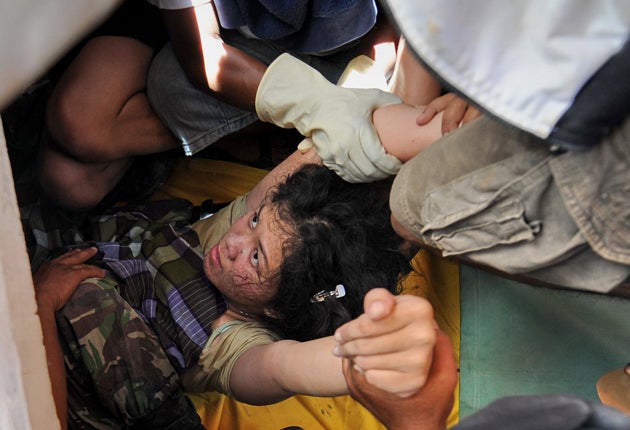Girl pulled from quake rubble as time runs out for survivors
Aid arrives for Indonesian rescue teams hampered by lack of heavy machinery

Amid scenes of grief and destruction in the Indonesian city of Padang, a ray of light pierced the gloom yesterday when a 19-year-old girl was rescued after 40 hours buried under rubble. But time was running out for other survivors, who called in desperation to emergency workers unable to reach them owing to a lack of heavy machinery.
As rescue teams from around the world rushed to help the coastal city two days after a 7.6-magnitude earthquake off Sumatra island, the stench of death was everywhere. However, the quake's worst effects may be yet to emerge. Areas around Padang remain largely cut off, but in Pariaman, a city of about 370,000 people, more than 10,000 buildings are thought to have been destroyed.
In the city, at the site of the three-storey Ambacang Hotel, up to 100 staff and guests were believed trapped in a mountain of tangled steel, concrete slabs and broken bricks. Rescue teams redoubled their efforts after detecting signs of life. "We heard some voices of people under the rubble, but as you can see, the damage is making it very difficult to extract them," said Gagah Prakosa, a spokesman.
While the international community has pledged to help Indonesia, and planes laden with aid have started arriving, efforts to organise a full-scale rescue operation are being hampered by blocked roads, downed power lines and patchy communications. "We don't have proper equipment. We don't even have dogs," said Suryadi Soedarmo, a surgeon working with experts trained to enter collapsed buildings. And finding seats on flights to the area has been extremely difficult.
The UN has estimated that 1,100 died in the quake, but the Indonesian government fears the death toll could be up to 3,000. The secretary general of the Indonesian Red Cross, Djazuli Ambari, told Agence France-Presse: "Looking at the situation, the chance of pulling people alive from the rubble is very slim."
Against those odds, Ratnia Kurniasari Virgo emerged, limp and covered in dust, but conscious, from the ruins of her foreign language school in central Padang. Her olive T-shirt was almost spotless, and her only injury was a broken leg. Rescuers had passed her biscuits and water as they battled for hours, eventually extracting her, hands-first, from a tunnel drilled in the wreckage. Excited workers shouted encouragement to each other in the final moments, and a crowd outside the school applauded as Ms Virgo was carried on a stretcher to a waiting ambulance. "She is fine, conscious, and does not have any life-threatening injuries," a nurse at the hospital, Nining Rosanti, said later. Ms Virgo's family had waited anxiously throughout the ordeal, fearing that her rescue might come too late.
In the end, she was fine. But Suci, another woman located alive at the same time, remains pinned under concrete. The 25-year-old, a teacher at the school, was lying next to Ms Virgo. Her husband, Tommy Erwinsyah, said: "Her leg is trapped under the concrete floor that fell on her. They can't lift or break it, so now they will try to use an air compressor to lift it." He added: "Last night I spoke to her. Her voice is very clear. I hope she can get out today. I went into the tunnel and I could hear her voice. I could see her hand."
It is not clear how many died in the rural, hilly district of Pariaman, but first reports yesterday suggested that virtually no buildings were left standing. The region has received no outside help, and locals have been left to clear landslides and dig out bodies using shovels and bare hands. "We haven't had any help from the government yet," one local, Ahmad Razali, told the Associated Press.
While those trapped alive in Padang are still awaiting rescue, the injured are overwhelming hospitals and the unharmed are in need of sustenance and shelter. "Today I pray for food and water," said Yudi Firman, a 43-year-old father of four. "I've been eating instant noodles. I don't even have water to drink."
International aid organisations are trickling into the city, with Britain, the US, Japan and Australia among the dozen or so countries sending aid, cash and specialist rescue workers. Yesterday 28 tonnes of supplies, including water, medicine and food, were flown into regional airports to be distributed. Relief workers gave tents to some of the tens of thousands of homeless.
But the process is painfully slow. "We need help from foreign countries for the evacuation efforts," said the Indonesian Health Minister, Siti Fadilah Supari. Priyadi Kardono, of the health ministry's national disaster management agency, said it was possible that nearly 3,000 people were still under the ruins. The challenge for rescue teams is that, as they deploy heavy machinery to shift steel and concrete in their search for survivors, their efforts could prove fatal to those still alive.
By last night, 775 people had been confirmed dead, with 2,400 in hospital. At Padang's main hospital, yellow body bags were lined up in neat rows in a makeshift outdoor morgue.
Join our commenting forum
Join thought-provoking conversations, follow other Independent readers and see their replies
Comments